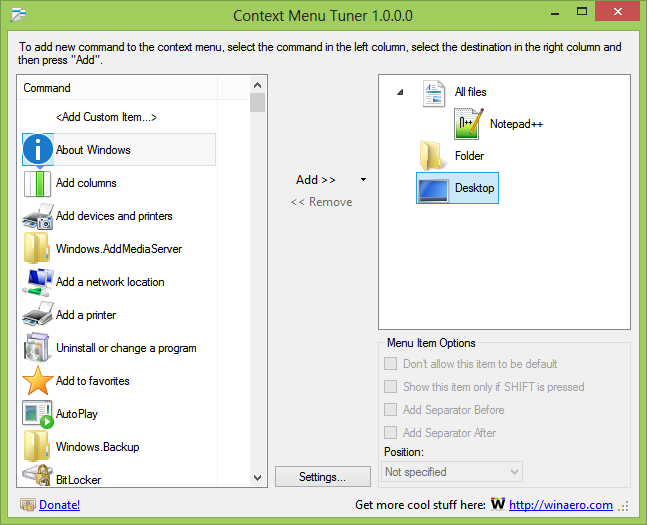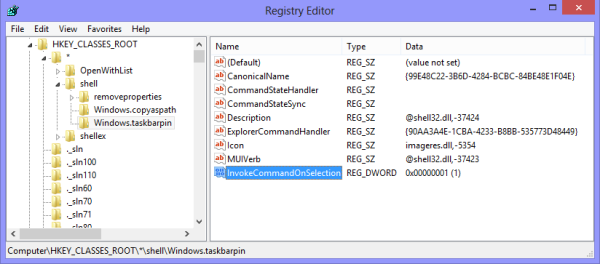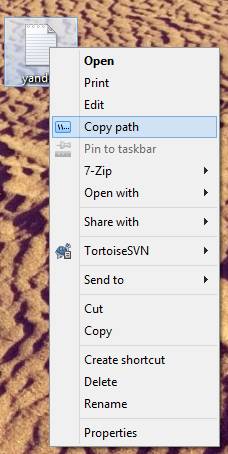In Windows 8, Microsoft has introduced the Ribbon in Windows Explorer so that the numerous Explorer commands can be more prominently displayed when you need them. But the Ribbon commands are still split across many tabs unnecessarily making you go through all of the tabs to find the command you need to use. There is the Quick Access Toolbar at the top where you can add custom commands but the problem is that it has only tiny 16 x 16 sized icons and no textual description. You need to hover over each of the tiny icons to see their description. Also, Desktop has no Ribbon, and most of the useful commands are inaccessible via right click.
In contrast, the right-click/context menu is a better option as it has icons as well as textual description, excellent keyboard usability and you don't need to remember which Ribbon tab a particular command is located on. Also, the Ribbon takes a huge amount of vertical space, so once you added the command to the context menu, you can keep the Ribbon minimized or disable it entirely with our Ribbon Disabler. ;)
Today I am going to share with you a cool trick which will let you add any Ribbon commands of your choice directly to the right click (context) menu of files and folders. Let us see how.
Advertisеment
The easiest way to add any Ribbon command to the context menu is to use Winaero's Context Menu Tuner. Ithas an easy-to-use interface and will allow you to add any command you want.
If you prefer doing it manually by editing the Registry yourself, read on.
In Windows 8, all of the Ribbon commands are stored in the registry under one single key for Explorer called "CommandStore". To access the Command Store, open Registry Editor and go to the following key:
HKEY_LOCAL_MACHINE\Software\Microsoft\Windows\CurrentVersion\Explorer\CommandStore\shell
Bonus tip: If you do not know how to do registry editing/tweaking, see our article: Windows Registry Editor for dummies. It will familiarize you with the fundamentals of the Registry and Registry Editor (Regedit.exe).
After expanding this key, you will see multiple subkeys which all correspond to the numerous Ribbon commands. Actually, the Command Store exists in Windows 7 and Windows Vista as well but unfortunately, this trick to add the commands to the context menu does not work reliably on Windows 7. It works for some commands, but may not work for some of them, so you can do this trick on Windows 7 as well, just be sure to test and check if the context menu command you added actually works. If it doesn't work, you will need to revert your changes.
On Windows 8, it works for all commands reliably. Also, more commands are included in Windows 8 Explorer's Command Store than previous versions.
1. In Registry Editor, assuming you have navigated to the ...\CommandStore\shell registry key mentioned above, select the registry subkey of any command you want to add to the right-click menu. For example, let us say I want to add the "Copy as Path" command to the right click menu. It will be shown without holding down the Shift key. Therefore, I will have to select the Windows.copyaspath registry key.
2. Right click this key and select Export. Give the file any name and save it. For example, "Add Copy as Path to context menu.reg".
3. Now you need to determine the registry key in the HKCR branch for which file type's context menu you wish to add this command. You can add it only for a particular file type, or you can add it for all file types, or even all folders and file system objects. In case of our command "Copy as path", it makes sense to add this to the HKCR\*\shell key of the registry as it is applicable to all file types. We want to be able to quickly copy the path of any file type. Therefore, the command we exported needs to be added to HKCR\* key.
Note: You must change this as required. For example, if you want to add a Ribbon command you exported to only the context menu of folders, you would have to add it to the HKCR\Directory\shell subkey. If you wish to add a command such as "Manage Library" to the context menu, it makes sense to add it only for Libraries, therefore you will have to add it to the HKCR\LibraryFolder key and so on. You get the idea - you need to add it for the appropriate file type.
4. Now you need to locate the file you exported in step 2. Go to the location where you saved it in Windows Explorer and open it in Notepad by right clicking the .reg file and choosing Open with -> Notepad. The contents of the Ribbon command I exported look like this:
Windows Registry Editor Version 5.00
[HKEY_LOCAL_MACHINE\SOFTWARE\Microsoft\Windows\CurrentVersion\Explorer\CommandStore\shell\Windows.copyaspath]
"VerbName"="copyaspath"
"CommandStateSync"=""
"InvokeCommandOnSelection"=dword:00000001
"MUIVerb"="@shell32.dll,-30329"
"VerbHandler"="{f3d06e7c-1e45-4a26-847e-f9fcdee59be0}"
"Description"="@shell32.dll,-30336"
"CanonicalName"="{707C7BC6-685A-4A4D-A275-3966A5A3EFAA}"
"CommandStateHandler"="{3B1599F9-E00A-4BBF-AD3E-B3F99FA87779}"
"Icon"="imageres.dll,-5302"4. Note the portion of text I highlighted in bold. You only need to replace this portion of text with HKCR\*\shell (or whatever HKCR subkey for the file type you want to merge it to). After making the change, it should look like this (I have highlighted the changed portion in bold):
Windows Registry Editor Version 5.00
[HKEY_CLASSES_ROOT\*\shell\Windows.copyaspath]
"VerbName"="copyaspath"
"CommandStateSync"=""
"InvokeCommandOnSelection"=dword:00000001
"MUIVerb"="@shell32.dll,-30329"
"VerbHandler"="{f3d06e7c-1e45-4a26-847e-f9fcdee59be0}"
"Description"="@shell32.dll,-30336"
"CanonicalName"="{707C7BC6-685A-4A4D-A275-3966A5A3EFAA}"
"CommandStateHandler"="{3B1599F9-E00A-4BBF-AD3E-B3F99FA87779}"
"Icon"="imageres.dll,-5302"5. The rest of the .reg file contents need to be unchanged. Simply save the changes to the .reg file, close Notepad and double click the .reg file to merge it along with the modified path back to the Registry.
6. That's it. After merging the command, try right clicking on the correct file type (any file type will do in case of *).
You will notice the command you just added.
Support us
Winaero greatly relies on your support. You can help the site keep bringing you interesting and useful content and software by using these options:



thks you very much,
love to modif, :p
You are welcome :)
I used this trick to add Folder Options to the context menu-worked!
But the reason why I did so, still isn’t available.
When I click on context menu Folder Options, the option in View tab to “Apply to Folders” is inactive-any suggestion?
Which context menu you added it to? This should work for folders:
Windows Registry Editor Version 5.00
[HKEY_CLASSES_ROOT\Directory\Background\shell\Windows.folderoptions]
“ExplorerCommandHandler”=”{83bb272f-7d5e-4b6e-9250-889893f0dac7}”
“CommandStateSync”=””
“Description”=”@shell32.dll,-31449”
“Icon”=”shell32.dll,-274”
Apply to Folders is not greyed out.